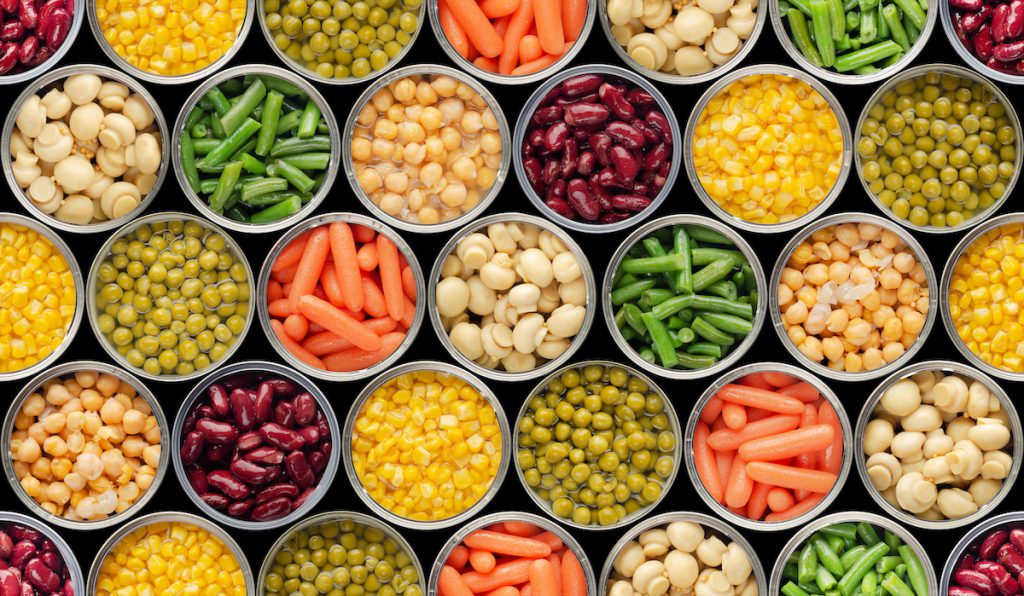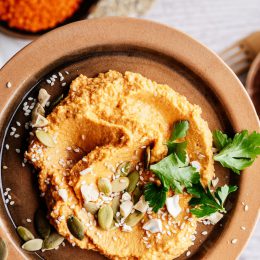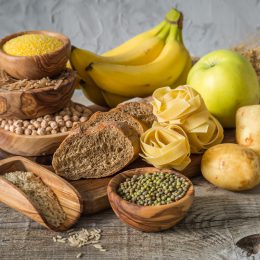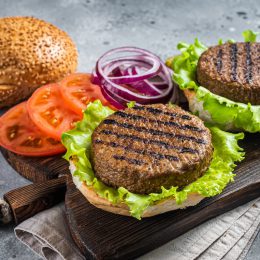Canned Foods Are Convenient, but Are They Good for You?
Cooking with fresh food is ideal. But research suggests you should still keep your can opener at the ready. Here’s what to know — plus, two recipes to try.

In a perfect world, we would all be making meals from scratch using only the freshest ingredients.
But in the real world, often we don’t have the energy or time for such kitchen tasks. And quality fresh fruits and vegetables aren’t always available to everyone all the time.
That’s where canned foods come in.
Canning is a method of preserving foods for long periods by packing them in airtight containers.
Canned foods can be a shortcut to getting meals on the table quicker and with less effort. But they are widely thought to be much less nutritious and flavorful than fresh or even frozen foods.
The truth is the canning process has less impact on nutrition than you may think. And with a lengthy shelf-life, you can stock up without much worry about costly food waste. Here’s what you need to know about these convenient food options.
Healthy eating and fitness go together! SilverSneakers classes and events are happening right now at participating gyms, online through SilverSneakers LIVE, and at community centers near you. Activate your free online account to get started.
Why Canned Foods Can Be Good for You
Fruits and vegetables are often canned immediately after being picked, when they contain their peak levels of nutrients. The canning process can even preserve some nutrients and antioxidants that are lost in fresh versions during storage and cooking.
In a Nutrients study, people who ate six or more canned items per week had higher intakes of 17 essential nutrients compared with those who ate two or fewer canned items per week. Some of the most nutritious foods out there come in canned versions, including fruits, vegetables, beans and fish.
It’s worth noting, however, that some heat-sensitive nutrients like vitamin C might be diminished to a certain degree during the canning process. That’s why it’s important to not rely too heavily on canned foods for your daily nutrition.
While there are many great canned food options, here are some you’ll want to keep in your pantry.
1. Canned Beans
These might be the healthiest fast food around. With a large range of essential vitamins and minerals (including iron, folate, magnesium and phosphorus) consider black, kidney and other canned beans almost akin to a multi-vitamin in a can.
No wonder people who eat more legumes, including canned beans, generally have a higher-quality diet.
Canned beans are also a fiber powerhouse, with up to 15 grams in a cup serving.
This might be a big reason why a 2021 Journal of Nutrition investigation found that daily canned bean consumption can help people with elevated cholesterol levels bring their numbers down for better heart health. This fiber can also improve blood sugar control and bowel movements.
What about those unpleasant gassy after-effects? It turns out draining canned black beans in a colander and then rising them well will send many of the gas-producing compounds down the drain.
Use canned beans in soups, chili, pasta dishes, and salads. Canned beans also make a great base for savory dips (see the recipe for pumpkin hummus, below).
2. Canned Peaches
Nobody wants to eat fresh peaches out of season, when they’re hard as a rock. Luckily, canned peaches offer a more flavorful year-round option. What’s more, canned peaches contain about as much vitamin C and folate as fresh peaches.
An easy fruit staple to keep in your pantry, canned peaches are great topping for cereal, yogurt, and salads, and the juice can be used to add a touch of fruity sweetness to salad dressings. Look for canned peaches (and other fruits such as pineapple chunks or mandarin oranges) that are packed in their own juice to minimize added sugar.
3. Canned Oysters
Oysters are a delicacy that you can enjoy without the hassle and danger of shucking them.
Though often overlooked for other canned seafood, tinned oysters deliver major nutritional benefits. Each can contains hefty amounts of protein to support muscle mass, as well as your full recommended daily amounts of vitamin B12, copper, and immunity-boosting zinc. You also get a decent amount of selenium, a mineral that may reduce the risk for stroke.
And did you know that canned oysters are a richer source of iron than beef? Iron helps make hemoglobin, a component of red blood cells that carries oxygen from the lungs to the rest of the body, including the heart, brain, and muscles. So coming up short in your diet can lead to poor brain functioning, fatigue and other health concerns.
These ready-to-eat oysters can be a healthy addition to soups, pasta dishes, and salads. Or simply enjoy them straight from the can for a high-protein snack.
4. Canned Tomatoes
Canned tomatoes are laced with the plant compound lycopene. This is a member of the carotenoid family that also includes beta-carotene (more on that later). Lycopene may help in the battle against cognitive decline as we age.
There is also some evidence that higher intakes of lycopene from foods like canned tomatoes may lower a man’s risk of developing prostate cancer.
Vitamin C is another nutritional benefit of using convenient canned tomatoes more often. This is an essential nutrient linked to improved blood pressure numbers. In addition, vitamin C enhances our absorption of iron from plant-based foods such as canned beans.
Canned tomatoes — diced, crushed, or whole — make an easy addition to pasta sauces, burritos, meat or lentil stews, chili, and, yes, classic tomato soup.
Recommended reading: 8 Delicious Ways to Eat Your Way to Better Brain Health
5. Canned Pumpkin
The holiday season shouldn’t be the only time you reach for the canned pumpkin in your pantry. Consider it a reliable source of the plant-based compound beta-carotene.
Our bodies can convert beta-carotene into vitamin A, which is needed to maintain eye, immune, and bone health. A 2023 Clinical Nutrition study found that people with higher blood levels of beta-carotene had less plaque build-up in their arteries, giving them a reduced risk of heart disease. Canned pumpkin is also a good source of vitamin K which is a nutrient important for supporting better bone health.
You can sneak canned unsweetened pumpkin puree into a pot of chili or into the batter of pancakes and waffles for some natural sweetness. It’s also easy to stir some into yogurt or oatmeal, or blend into smoothies.
Or blend with chickpeas for this sweet-and-savory hummus.
Subscribe to our newsletter
It's quick and easy. You could be one of the 13 million people who are eligible.
Already a member? Click to discover our 15,000+ participating locations.
Follow Us
Pumpkin Hummus
Blend together:
- 1 15-ounce can unsweetened pumpkin puree
- 1 15-ounce can chickpeas (rinsed and drained)
- 3 tablespoons tahini
- 1 tablespoon lemon juice
- ¾ teaspoon ground cumin
- ¼ to ½ teaspoon kosher salt
- Sprinkle a dash of paprika on top before serving
6. Canned Salmon
You can do a lot worse than casting your line for canned salmon during your next grocery trip.
For starters, salmon in a can is a stand-out source of omega-3 fats. A study from Tufts University in Boston suggests that people may be more likely to age without health problems when they have higher blood levels of these superhero fats. Omega-3s help promote healthy aging by improving blood pressure, endothelial functioning, triglyceride levels, and reducing inflammation.
Ounce for ounce, canned sockeye salmon has omega-3 levels on par with the amount you’d get from fresh salmon. (Canned sockeye has higher amounts of omega-3 fats and vitamin D than pink salmon.) If you buy canned salmon with the edible bones that have been softened during the canning process, you’ll get much higher levels of bone-strengthening calcium than you would from fresh fish.
Plus, canned salmon contains about 18 grams in a 3-ounce serving, making it helpful for preserving muscle mass during aging. And it’s typically less expensive than a fresh cut of fish.
It’s easy to use canned salmon in sandwiches, but it’s also a nutritious alternative to ground meat in this loaf recipe.
Salmon Loaf
- 3 cans pink or sockeye salmon, drained
- 2 large eggs, lightly beaten
- 1 cup quick-cook oats
- 1 large carrot, grated
- ½ cup finely chopped red onion
- 2 garlic cloves, minced
- 1 teaspoon Italian seasoning
- Juice of ½ lemon
- 3 tablespoons prepared horseradish (optional)
- ¼ teaspoon salt
- ¼ teaspoon ground black pepper
- 1/3 cup barbecue sauce
Directions: Preheat oven to 350°F. In a large bowl, flake salmon with a fork and stir in eggs, oats, carrot, onion, garlic, Italian seasoning, lemon juice, horseradish if using, salt and pepper. Add salmon mixture to 9×5-inch greased or parchment paper lined loaf pan and spread until the mixture is of even height and width. Bake for 30 minutes, then spread on barbecue sauce. Bake for another 10 minutes (or until the internal temperature is 160°F).
Recommended reading: Healthy Eating for Older Adults: The SilverSneakers Guide
A Word on Salt
Some canned foods can be high in salt, particularly fish and beans. While this does not pose a health risk for some people, it may be problematic for others, such as those with high blood pressure.
If salt intake is a concern for you, choose the “low sodium” or “no salt added” options that are increasingly available on store shelves. Also, know that placing canned beans in a colander and rinsing them well with a stream of water will significantly lower their sodium content.
See our sources:
Nutritional comparison of canned vs. fresh and frozen produce: Journal of the Science of Food and Agriculture
Link between canned food use and higher nutrient intake: Nutrients
Link between lycopene consumption and prostate cancer risk: Medicine (Baltimore)
How beta-carotene helps prevent heart disease: Clinical Nutrition
How omega-3s contribute to healthy aging: BMJ
Check Your SilverSneakers Eligibility Instantly
SilverSneakers members can go to thousands of gyms and fitness locations across the nation, plus take SilverSneakers LIVE online classes that are designed for seniors of all levels. If you have a Medicare plan, it may include SilverSneakers — at no additional cost. Check your eligibility instantly here.
Already a member? Get your SilverSneakers member ID and exclusive fitness content by activating your online account here.
Not eligible for SilverSneakers? You can still get 200+ free SilverSneakers On-Demand videos and stay in touch with us by creating your online account.





